| McDonnell-Douglas F-15A Eagle 77-068 |
This aircraft is a non-flying static display at Arnold Engineering Development Center at Tullahoma, TN. There is some more information pertaining to the aircraft on the AEDC web site at This Link |
Note that all images are thumbnails to larger images. You can click the thumbnail to view the large image, then click [BACK] on your browser to return to this page. | |
 |
Aircraft 77-068, F-15A from Eglin AFB, Florida. Now permanently stationed
outside of Gate 1 at Arnold AFB at Tullahoma, TN.
Right side of fuselage, overall view. |
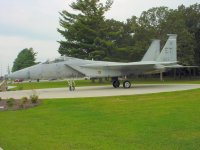 |
Left side of fuselage, overall view.
Notice in this photograph, and the preceeding one, that there is no evidence of any camouflage at all. There is no "Ghost" scheme or "Mod Eagle" scheme or anything. The aircraft is just plain gray all over. You can also see how stark the panel lines are in relation to the overall weathered appearance of the aircraft. |
 |
Closeup of outside of canopy and windscreen, left side.
Something for a modeler to take note of is that there is a stainless steel band around the edge of the canopy and windscreen. We tend to always paint the canopy framing the fuselage color, and in many cases that would be correct. For this particular aircraft, or perhaps type of aircraft, it would be incorrect. Also notice that inside the canopy you can see the yellow straps and red streamer of a "Remove Before Flight" flag that goes between the pitot tubes of the ACES-II ejection seat. |
 |
Closeup of outside of canopy and windscreen, right side.
As in the previous photograph this photo shows the stainless steel band around the edge of the canopy and windscreen. This photo also shows the yellow straps and red streamer of the "Remove Before Flight" flag that goes between the pitot tubes of the ACES-II ejection seat better than the previous photo. |
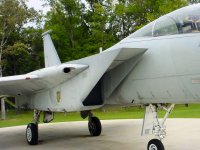 |
Starboard intake and cannon fairing
This photo is a general closeup of the right front corner of the aircraft. Things to note in this photograph are the small red navigation light on the leading edge of the wing (there would be a green one on the other wing), and the stainless steel fairing around the Vulcan cannon housing. You can also see a good bit of detail of the nose gear in this photo. The fifth picture down you have that the red light is a navigation light. It is in fact an Anti-Collision light. The position lights that you are referring to are on the wingtips and there would not be a green one, there would be a blue one on the left wing. Green is for boats. |
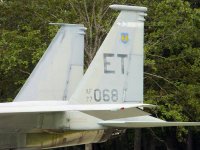 |
Left Vertical Stabilizer
This photo shows the left vertical stabilizer and also shows the generally worn appearance of the aircraft. Also take note of the ECM antenna on the top of the left vertical stab and the counterbalance on the opposite stabilizer (at least that's what I was told they were!). |
 |
Aft Panel, Left Side Of Aircraft
This panel is on the left side of the aircraft at the bottom. You can see the location of it on the photo of the left vertical stabilizer above. The reason that I took it was because of the sheen that it has. Keep in mind that this aircraft has been holding down a "Gate Guard" position for a good while and has not been maintained at all (evidenced by the overall weathered look of the paint) however this panel is so bright and shiny that you can see a distorted image of my reflection in the surface. It is obviously some sort of stainless steel or alloy that does not corrode, weather, or lose its shine even when exposed to the elements. Next is the Aft Panel Left Side. That panel is Titanium. Thatís why itís so shiny after all these years. We would spend hours polishing those panels and the wheel hubs to make them look really nice. Then the pilots would go fly around and get black streaks all over our nice shiny panels. |
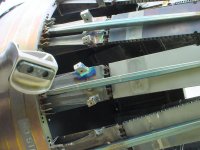 |
Starboard Afterburner
You can see in this photograph that the afterburner section is the original style with the "Turkey Feathers". Also take note of how the components are discolored from the extreme heat generated. It was pointed out to me that the cans are lacking every other "feather". The small bracket protruding should have "bell cranks" and linkage attaching each feather to each other. This is what controlled the opening and closing of the feathers. (Thanks Mel!) Starboard Afterburner Ė The reason for discoloration is years in the elements. Not extreme heat. There is a cushion of cool air between the exhaust and the turkey feather to prevent burn-through. |
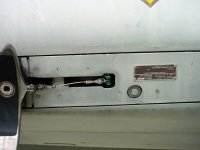 |
Missile Clamp, Bottom of Left Intake
This photograph shows one of the clamps that hold the Sparrow missiles. It is on the bottom of the intake and if I remember correctly it was on the left side (you can see a similar one on the photo of the right intake above). I originally had this shown as a "Sidewinder" missile clamp and it was pointed out to me that the Sparrows were carried on the intakes (thanks Mitch!). Missile Clamp Bottom Left Ė These arenít clamps. They donít hold the missiles in any way. These are actually pistons that push the missiles away from the aircraft before the rocket motors ignite. This is to obviously keep from shooting yourself with a missile. Also, the AIM-7 Sparrow is no longer used. I launched the jet that fired the last one a few years ago with the guy that designed the AIM-7 in the backseat. 120 AMRAAMs are what are used now. |
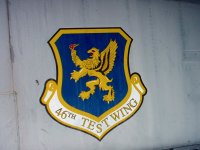 |
46th Test Wing Emblem
Closeup of the logo of the 46th Test Wing, Eglin AFB, Florida. |
The following images were taken by Dave Master and are included on this site with his permission. My thanks to Dave for providing them. I was having a difficult time finding out exactly what the "Metallic Green" color used in Bay 5 was and he provided these photographs. | |
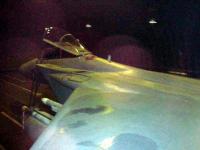 |
Night Shot
An interesting night shot of an F-15 on the ramp. |
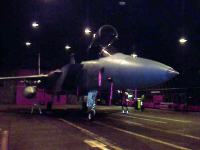 |
Night Shot
An interesting night shot of an F-15 on the ramp. |
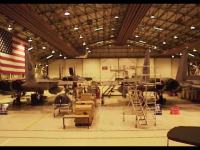 |
Two In The Hangar
A Pair of Eagles in a hangar. |
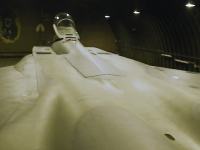 |
Top Front
This is a view of an Eagle that not many people see. Air shows will let you look at them all you want from the front, sides, rear, and bottom, but very few of us are able to see the top of one. |
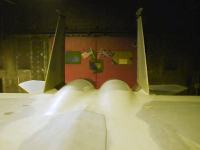 |
Top Front
Another top view, this time facing to the rear. |
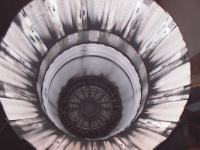 |
Engine Exhaust
This is the exhaust end of one of the engines. The "Thrust Augmenters" on the F100-PW-220 engines are ceramic coated to protect the metal from the extreme heat generated by the afterburning engine. They will always be white or ash-gray inside, and stained with black in places. |
 |
Electronics Bay 5
This is a view of Bay 5 right behind the cockpit. The TEWS (Tactical Electronic Warfare System) units are visible at the right. |
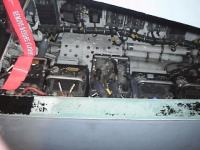 |
Electronics Bay 5
The right side of electronics bay 5. This photograph is significant because you can see that the bay has been repainted gloss white, but on the sill at the bottom of the photograph you can see remnants of the infamous "Metallic Green" color that drives modelers crazy. |
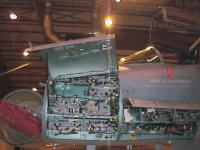 |
Open Bay
Not being an Eagle maintainer I don't know specifically what bay this is. You can see the "Metallic Green" color that is so prevalent through the aircraft. It is an anti- corrosion coating and according to Dave is the primary color used to coat the bays of the aircraft. You can also see the open radome at the left of the photograph. Open Bay Ė That is door 3L. Itís not a bay. Panels come completely off. Doors have hinges. ďBaysĒ are empty unless components are installed. Such as the engine bay and bay 5. Bay 5 is actually full of stuff on newer C-model ACC aircraft. |
| NOTE:
ALL of the photographs on this page are copyrighted by the author and my NOT be used for any
purpose other than personal use. Their inclusion or use in any commercial venture is
absolutely prohibited without the express written permission of the author.
The purpose of the photographs on this page is to provide a source of information to modelers and fans of the F-15 for informational purposes. They are not intended to be used to make someone a profit and that type of use will not be tolerated. | |
